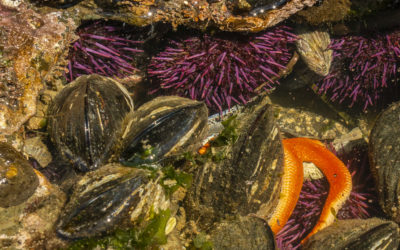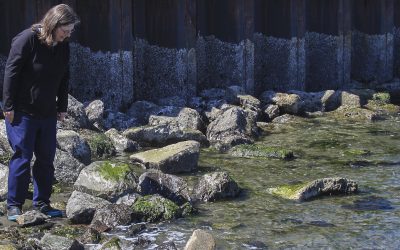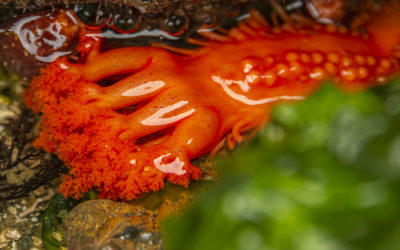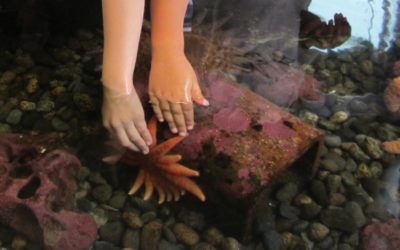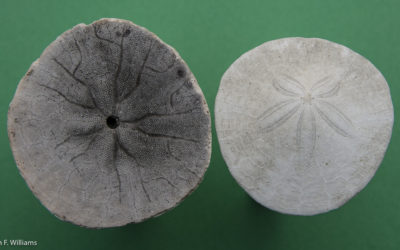It's a Star Eat Star World
by Paul Pegany
Photos & video by John F. Williams except where noted
Some of the variety of local sea stars. Photo by Sharon Pegany
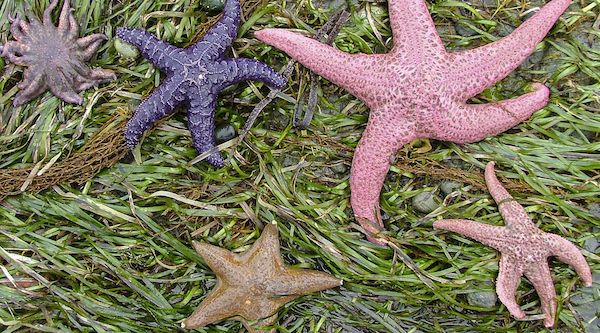
Some of the variety of local sea stars. Photo by Sharon Pegany
Star Eat Star World
By Paul Pegany, Summer 2019
Photos & video by John F. Williams except where noted
Washington’s Pacific coast is a world of mighty creatures and perilous dangers for those who dare to venture into its depths. Terrifying images of great white sharks, stings of jellyfish, and shocks of electric eels give us pause to enter their murky domain. The open ocean is definitely a fish eat fish environment.
Conversely, the quiet dripping pools of the intertidal zone, particularly here in the Salish Sea, might appear to be tame by comparison. But, don’t be fooled; some of the ocean’s most merciless predators frequent these seemingly calm environments. Unlike the vast underwater space open ocean animals use to escape, hide, or camouflage, creatures of tide pools are trapped in a relatively small area for hours at a time. Yet, each is endowed with abilities that enable it to thrive in such compact environments.
These hardy creatures find themselves essentially in the lion’s den with every low tide and face both marine and terrestrial rivals for food and survival, not to mention drastic changes in water currents, sun, heat, moisture, salinity, and wind. Tide pool animals are an important part of the balance of the food web on both land and sea.
In addition, easy access to tide pool animals helps humans better understand the interconnectedness of these creatures, both with each other and the greater marine environment. Intertidal creatures are often the initial indicators of environmental changes, such as poor water quality, and bear witness to the impacts of warming oceans due to climate change.
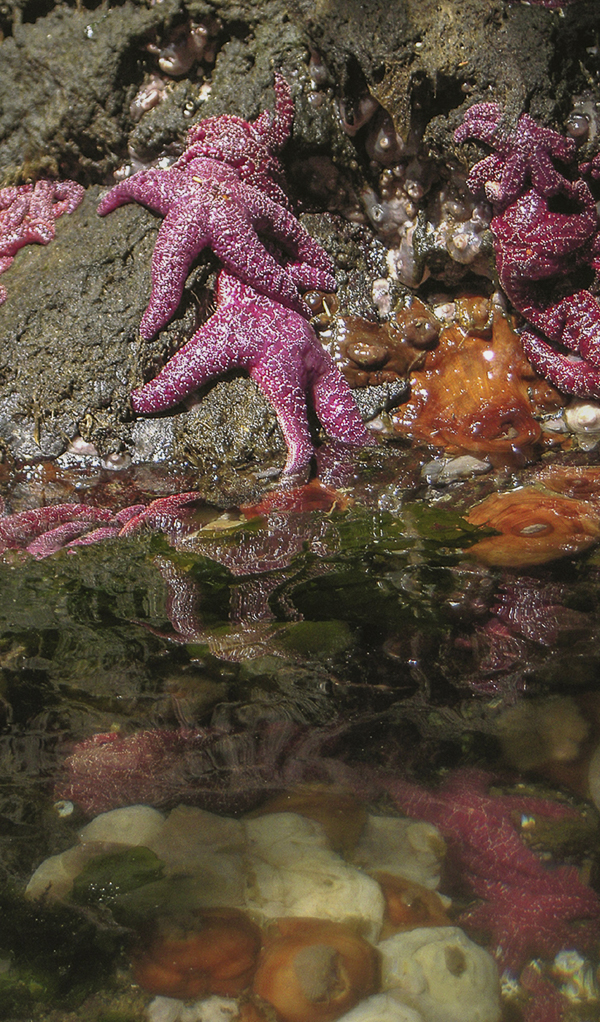
Photo by Nancy Sefton
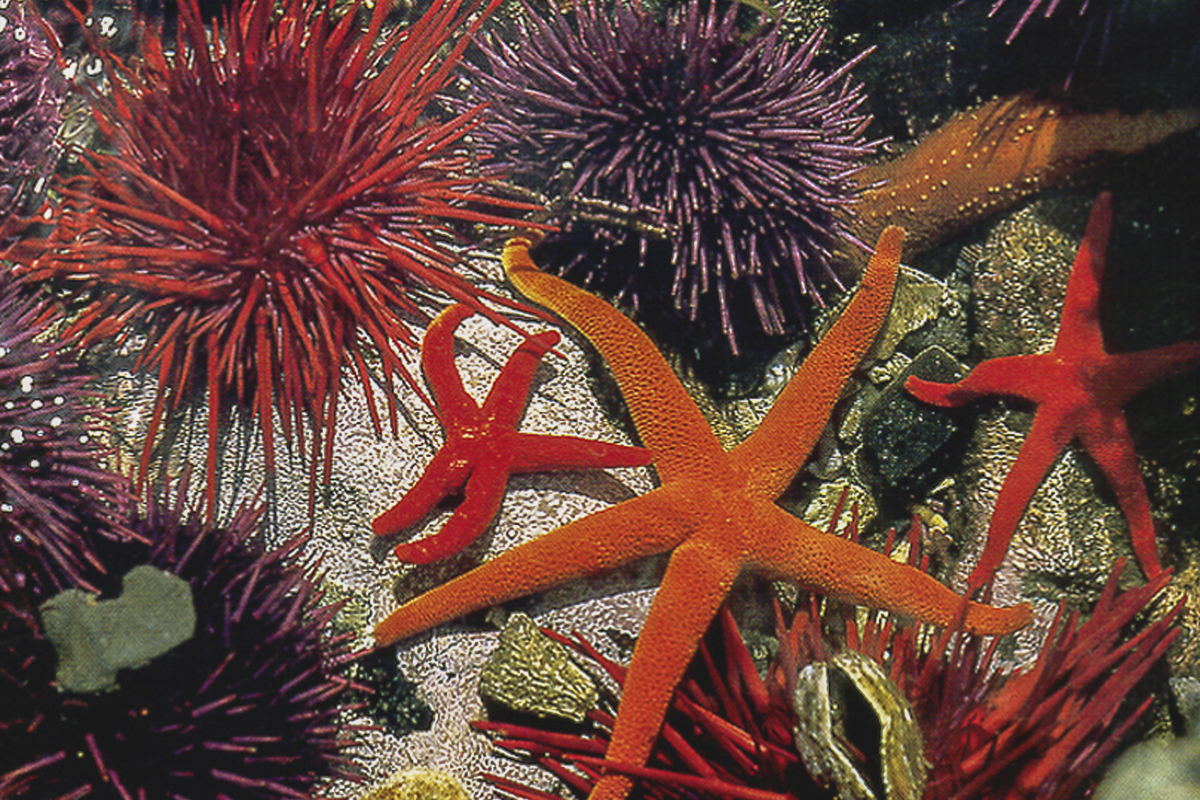
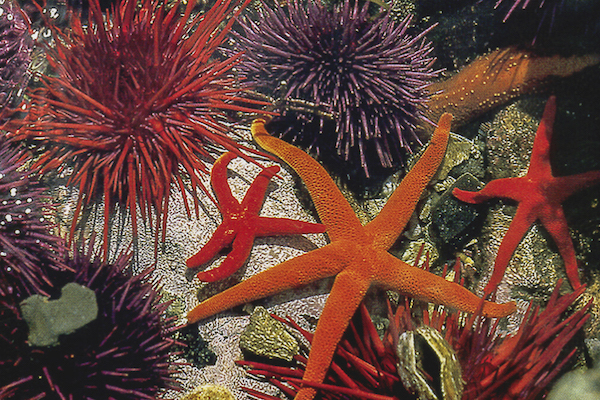
Photo by Nancy Sefton
Probably the most iconic tide pool creatures in the Pacific Northwest are sea stars and their echinoderm cousins: sand dollars, sea urchins, and sea cucumbers. The term echinoderm comes from the Greek, which means spiny skin. Echinoderms all share five part symmetry, an endoskeleton, and a remarkable internal “engine” unique to echinoderms known as a water vascular system.
This system is a network of small muscular canals and cavities that connect a central disc with the animal’s tube feet. By filling and releasing water, this clever hydraulic system leverages water pressure enabling the animal to move as well as grip surfaces and prey with great strength. Echinoderms use their water vascular system not only for locomotion and feeding, but also for waste removal and respiration.
While echinoderms share many commonalities, their appearance and means of survival greatly vary. The stories of these spiny creatures are worth knowing and give us a fresh appreciation for their tenacity and interconnectedness.
Tubefeet in action!
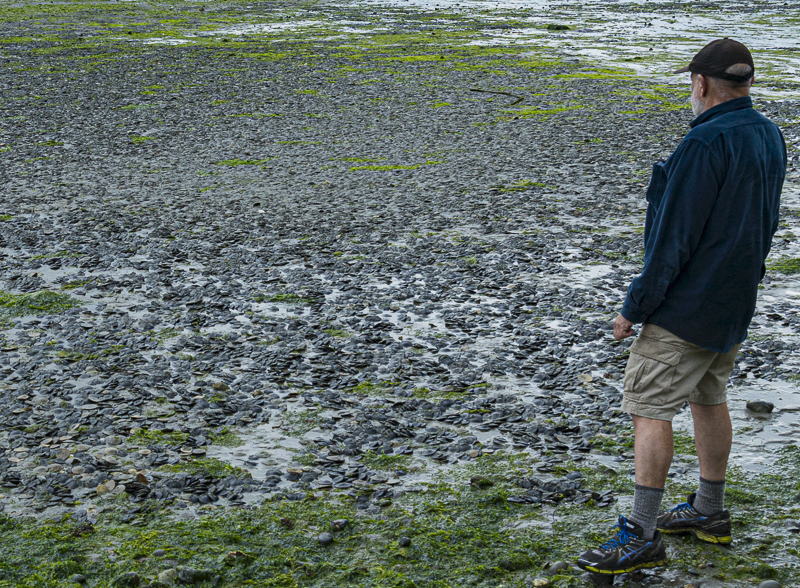
tide pooling for dollars
Most longtime Salish Sea residents can remember the youthful excitement of finding a sand dollar “test” or exoskeleton lying on the beach, its white shell devoid of spines, revealing its intricate star pattern. But, visitors, newcomers, and even some veteran Salish Sea inhabitants are often unaware that this chalky treasure is simply the skeletal remains of a living organism. The easiest way to identify a living sand dollar is to look for tiny deep purple spines covering its body. Wet sand dollar spines glisten and shimmer in the sun as they move and can even create a slight tickling sensation on an open palm.
Sand dollars are frequently found in sandy tidal zones in areas where water pools at low tide. Considered the “urban dwellers” of the beach, they congregate tightly in groups of up to 625 dollars per square yard, often packing into condo-style stacks one against or on top of the other.
Rather than aggressively hunting for their food, sand dollars prefer to eat at home and let their meals come to them. As the tide comes in, sand dollars feed on algae, diatoms, and crustacean larvae. When capturing a meal, their spines close together around their prey into a teepee shape. From there, the spines work assembly-line style to move the prey to the mouth, located on the bottom center of the sand dollar, where a jaw with five teeth-like sections grind up the food, sometimes for up to fifteen minutes before swallowing. Their “teeth” are much like those of the sea urchin, shown in the section below.
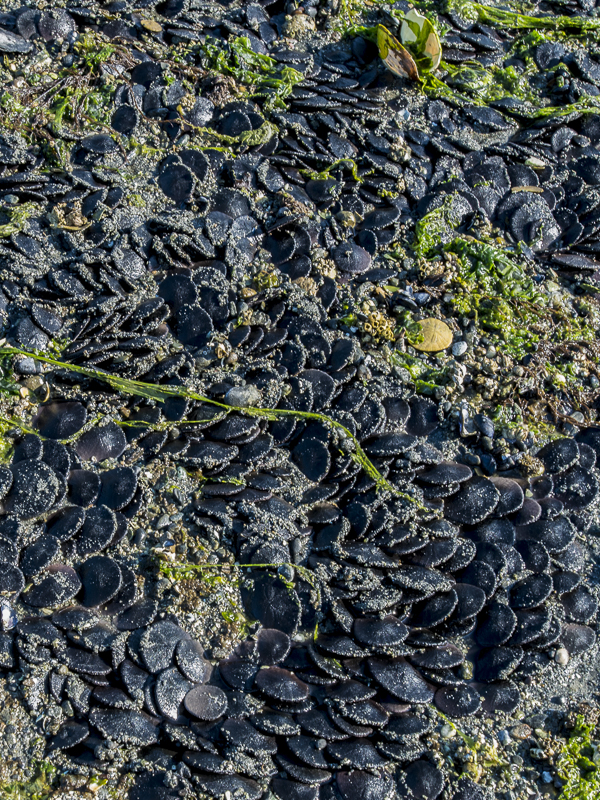
Sand dollar spines are also multi-functional. As well as transporting food, they also allow the sand dollar to move slowly across or burrow down into the sand, angling its bottom side to the incoming tide in gentler tidal zones. However, in areas of stronger tidal zones, sand dollars will lie flat on the sand and even take sand into their skeletons to provide weight against the tidal onslaught.
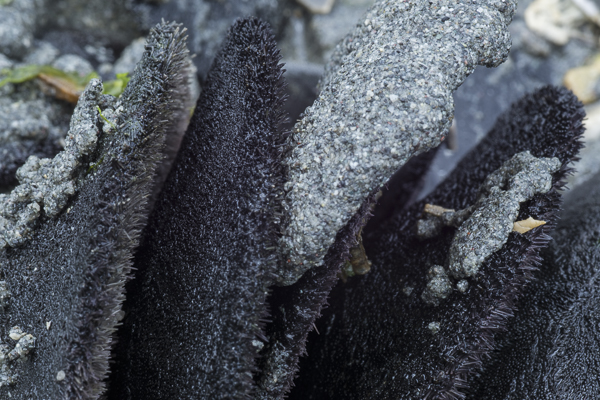
But, in this echinoderm eat echinoderm world of the tidal zone, the main predator of the sand dollar is its cousin, the pink spiny sea star. As the sand dollar detects this approaching predator, it quickly buries itself under the sand, safe from the treacherous tube feet of the pink star. In fact, observers have noted pink stars moving through a bed of sand dollars, leaving a path of smooth sand as the dollars scurry under the sand to avoid being their cousin’s next meal.
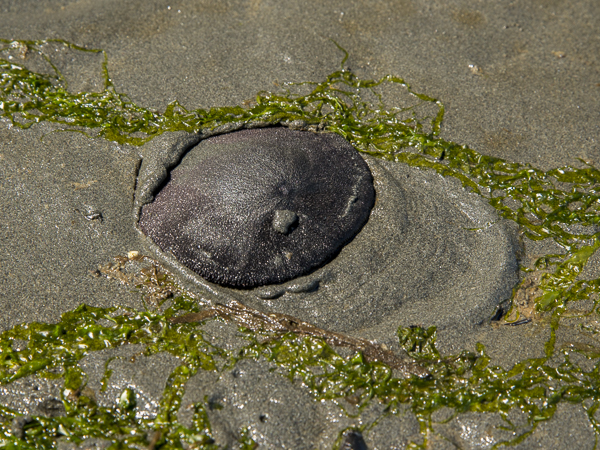
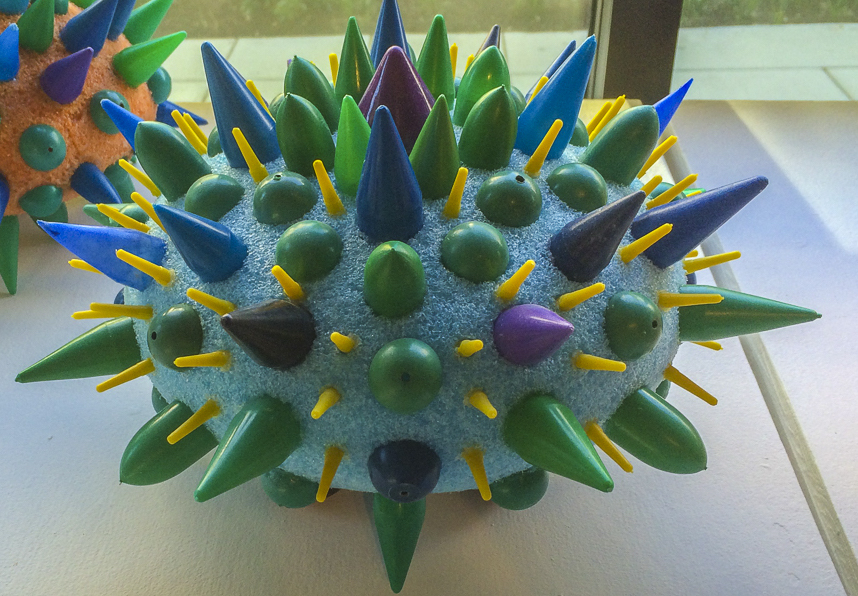
American Sea Urchin II by Karen Hackenberg, Beach-found flotation foam and plastic fireworks tips
sea urchins: offense and defense in a purple spine
Gaze into a Pacific Northwest tide pool and you might spot a purple sea urchin. These regal-colored pincushion look-alikes are found on rocky shorelines of both the Salish Sea and the Pacific coast. In the Salish region, you are more apt to find them on the more rugged Straits of Juan de Fuca and Georgia versus the sand and gravel beaches of Puget Sound.
Sea urchin health is also an excellent indicator of water quality, as they are one of the first creatures to show signs of stress in polluted waters. In such situations, they limit movement, their spines will droop, and the animal will eventually die, leading to declines in their overall numbers in waterways impacted by pollution. Sea urchin die-off, in turn, impacts all plant and animal populations within a specific food web.
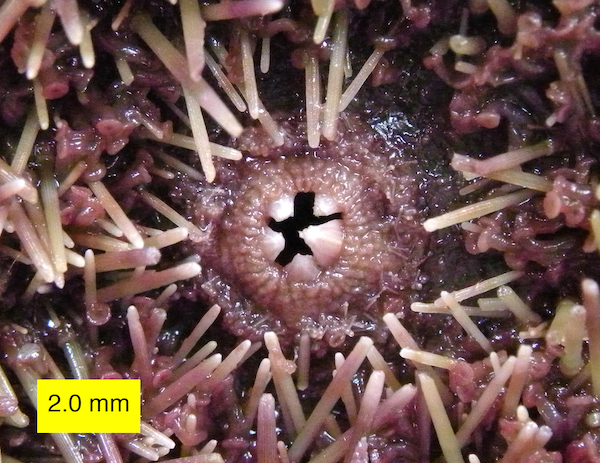
The structure of a purple sea urchin’s mouth, with its five teeth, is known as Aristotle’s lantern. This photo also shows the spines and tube feet. Photo courtesy of Wilson44691, Creative Commons CC0
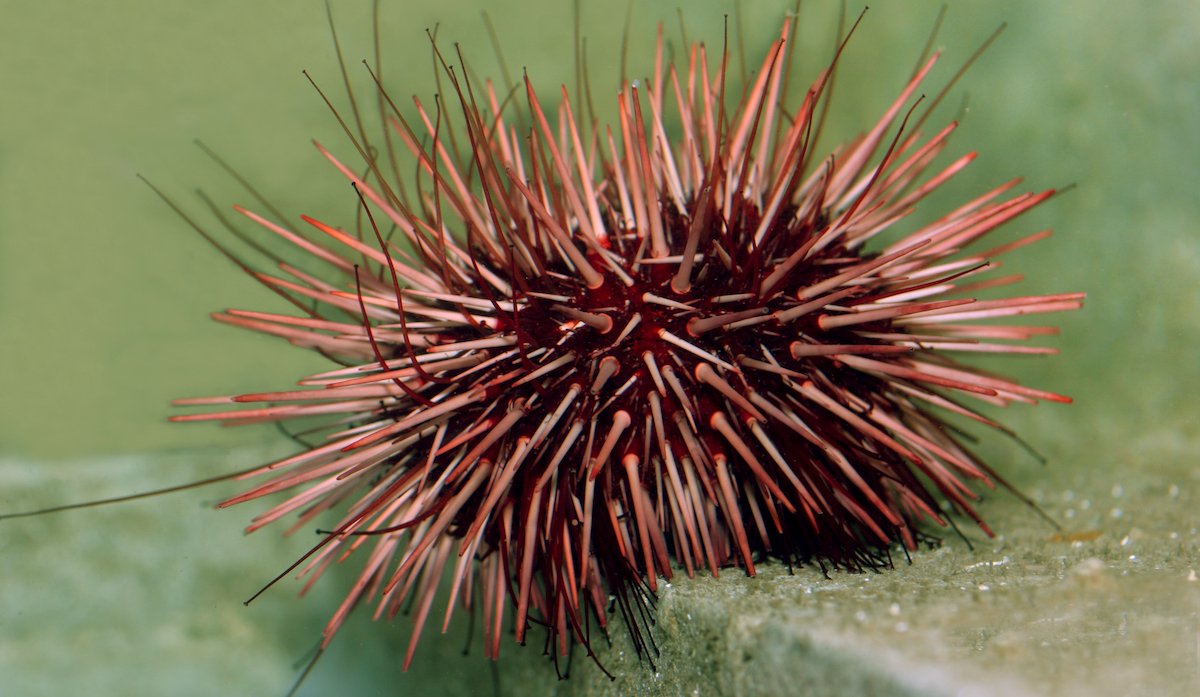
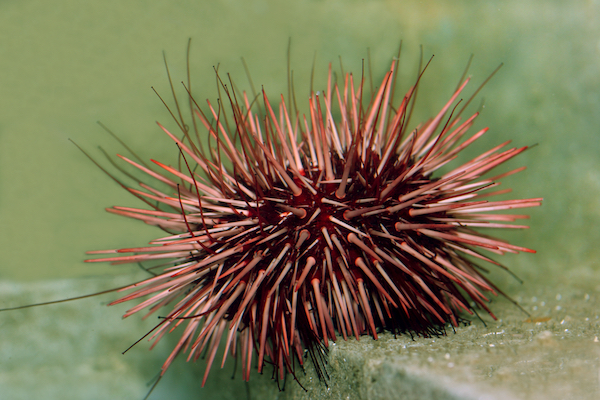
Urchin’s tube feet being use for locomotion. Image courtesy of Feiro Marine Life Center
The tests, or outer shells, of the sea urchin are covered with tube feet on its underside, as well as its signature purple spines which move on ball-and-socket style joints covering the rest of its test. Down in the spines on the test surface there are also small pincer organs which, while not totally understood, are thought to assist the urchin in keeping clean, as well as transferring food to its underside.
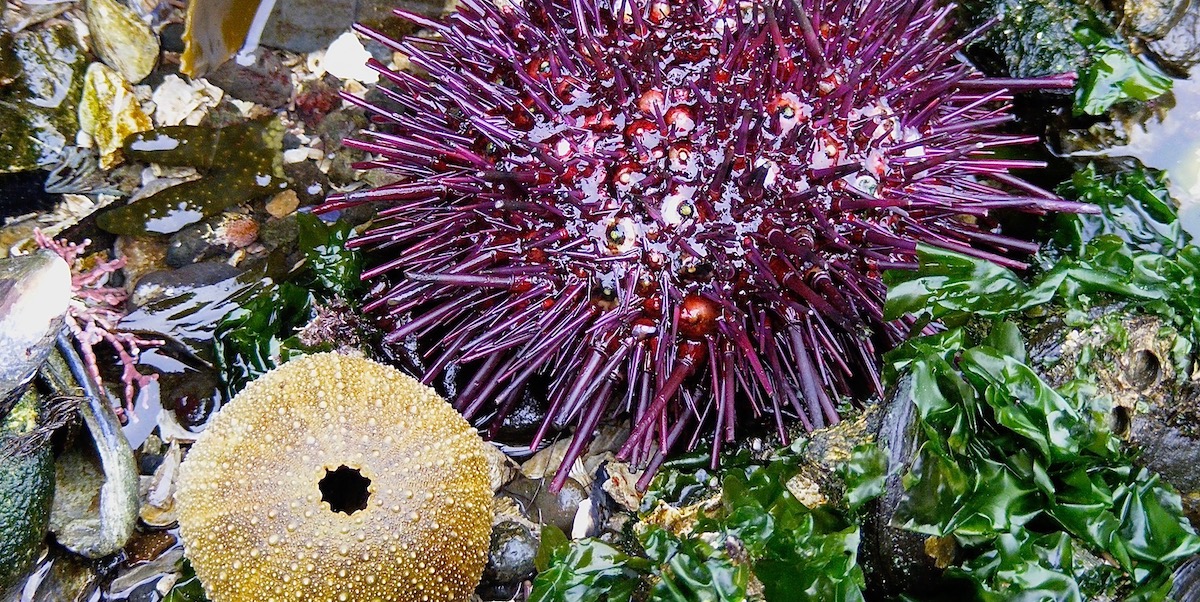
An empty test next to a live sea urchin. Photo by Sharon Pegany
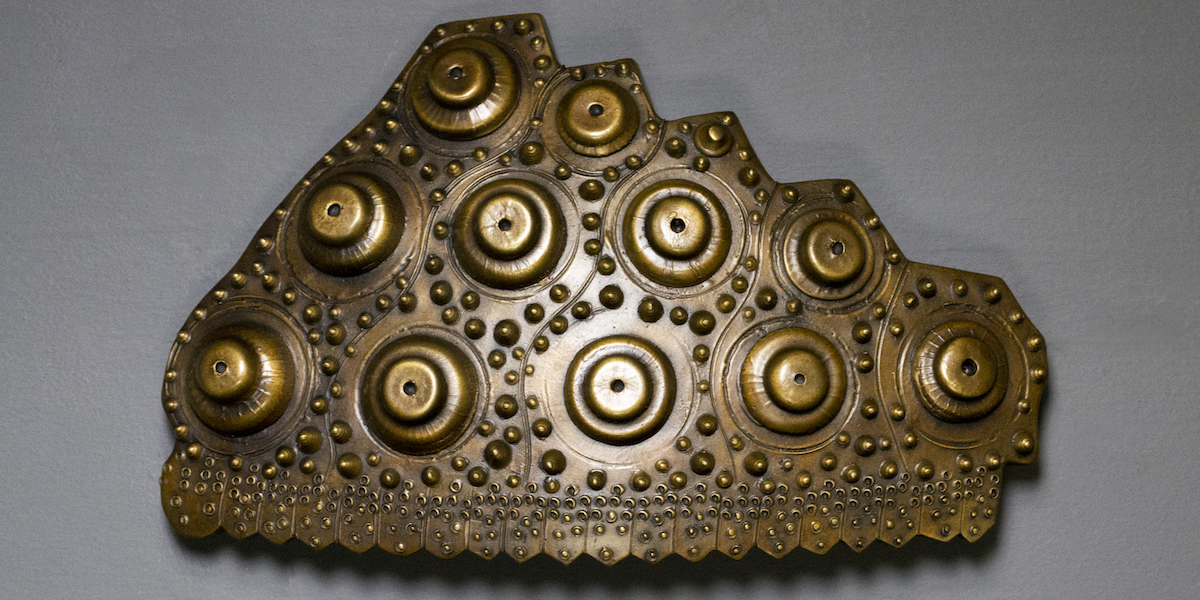
This bronze sculpture gives a close-up view of a fragment of a sea urchin test. Compare with photo above. Sculpture by David Eisenhour, photo by Ann Welch
Gently place a finger down into the spines and you will immediately feel them closing in on your adventurous finger. These spines help protect the urchin from predators, while also enabling it to spear its favorite food, brown and green algae, particularly bull kelp.
In a tide pool environment, sea urchins use their tube feet to anchor into the pool and use their tooth-like plates and spines to drill into the stone of the tide pool to create a rocky hideout. But, woe to the urchin who lingers too long in its hideout. If an urchin outgrows its carved out home, it is literally “stuck for life” in that one spot and must survive on whatever drifts its way.
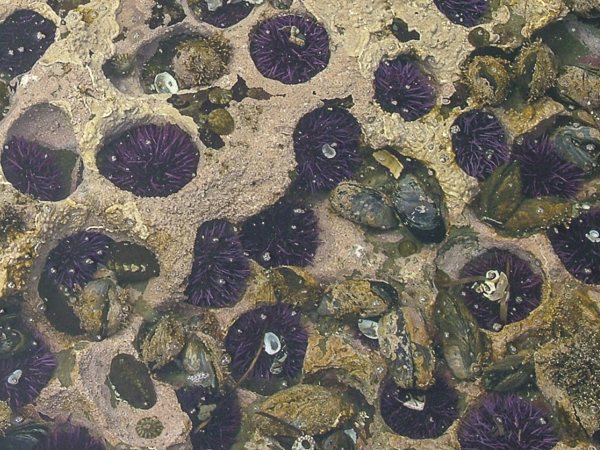
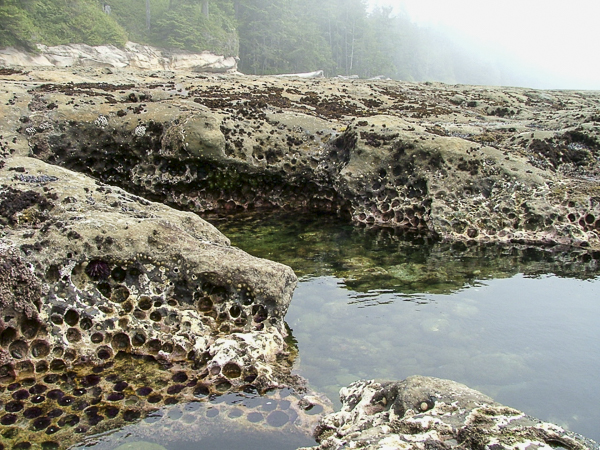
Urchins inside the holes they carved into the rocks. Photos by Sharon Pegany
While tidepool urchins lead a relatively solitary life, quietly eating various algae and kelp that come into their tidal zones, urchins who live in the deeper zones live in large colonies and are voracious predators of bull kelp. A dense group of seafloor urchins will completely devastate a kelp forest, eating away at the stems of the algae, called stipes, until the area is completely barren.
However, like all creatures of the sea, purple urchins have their own predators, namely sea stars and sea otters in open coastal areas. (Prior to 1900, sea otters were hunted to near extinction along the Pacific coast. Through recovery efforts in later years, sea otters in the Salish region can be found in the Strait of Juan de Fuca, and infrequently in Puget Sound.) But, the urchins have some tricks up their spiny sleeves to fend off their sea star predators. When a star approaches an urchin, the urchin will open its spines wide to allow the sea star to get closer, and even poke an arm between the spines. Suddenly, the urchin will snap its spines on to the star’s tube feet. Ouch! The smarting star will often beat a hasty retreat.
Otters v. Climate Change, KQED QUEST, A brief history of otters off the coast of Washington State and their impact on sea urchins, kelp, and the environment.
This strategy works well against most sea stars, but is not effective on the dreaded sunflower star for whom purple sea urchin is a primary food source. In that case, the urchin only has two options, get out of the way as quickly as possible, or risk being swallowed whole by the sunflower star. Unlike the one-piece skeleton of most sea stars, the sunflower star has a few disconnected pieces to its skeleton, allowing it to open wide to swallow creatures like sea urchins whole. It digests the urchin, then spits out the remaining shell. As for the many pokes in the stomach from the urchin spines? The sunflower star has an amazing ability to quickly heal from the injuries and move on to its next victim.
Just as sea urchins don’t have much defense against sunflower stars, they also have little defense against sea otters, who use their front paws to simply break off the spines, then break the shell with their teeth. However, in the case of the otters, the urchins do get the last laugh. A sea otter who munches on sea urchins will find that its teeth and bones turn the same shade of purple as their delectable prey bringing to mind the old adage that “you are what you eat!”
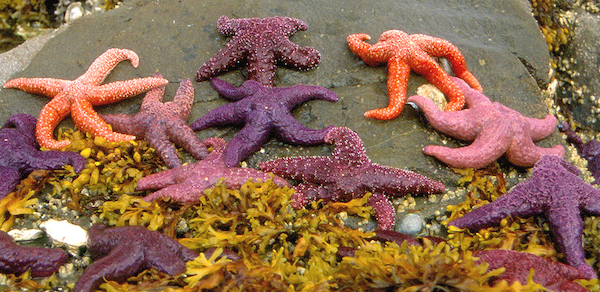
Photo by Nancy Sefton
even the biggest stars have their troubles
My first echinoderm experience was on the sandy shores of eastern Vancouver Island back in the early 1990s. While I was thrilled by holding live sand dollars and intrigued by the lovely sea urchins, nothing left me as giddy as the incredible array of brightly colored sea stars. In those days, the shores of the island were covered by a variety of species: purple ochre stars, large spiny pink stars, and smooth leather stars, all of which were found with incredibly regularity.
However, the Grand Prix of sea stars was also found in those halcyon days on Vancouver Island: the sunflower star. One of the world’s largest and heaviest sea stars, the sunflower star has 16 -24 arms and can grow to the size of a manhole cover. It glides with surprising speed over sandy surfaces using its 15,000 tube feet for locomotion. It was the star you looked at in place without picking up due to its imposing size and flexibility. These stars are less tolerant of dry conditions in the intertidal zones. As such, the best place to see them are in the tide pools of the lower tidal zone or the sandy beach floor at the lowest intertidal zones.
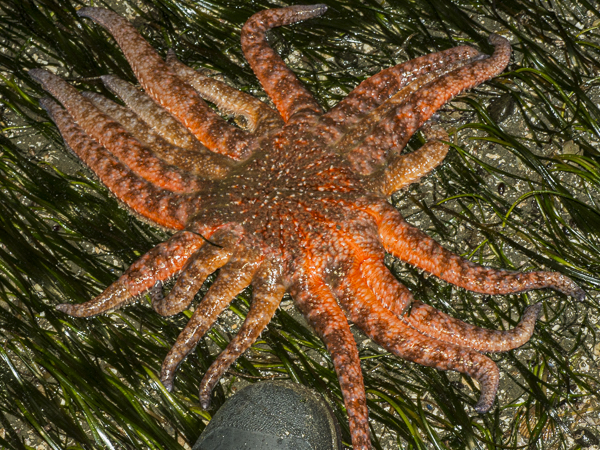
The boot-tip in the photo is almost dwarfed by the sunflower sea star.
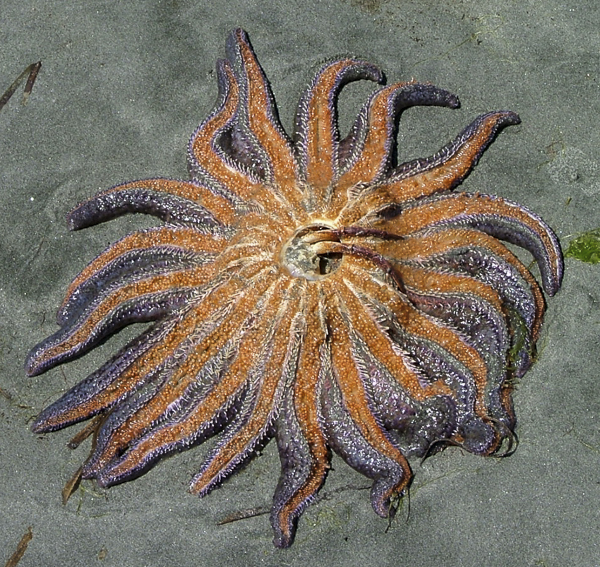
This sunflower sea star has a couple of crab legs sticking out of its mouth. Photo by Sharon Pegany
These voracious stars will eat almost anything in their paths including crabs, snails, sea cucumbers, chitons and urchins, as well as dying fish and squid. Other sea stars are dwarfed by this star, so they fall prey as well. When feeding, many sea stars extend their stomachs to pry open, surround, and digest food. With its extra heft and bravado, the sunflower star dispenses with the genteel manners of such food preparation. Rather, it uses its powerful tube feet on the underside of its arms to grasp and move its prey to its underside stomach and swallows it whole. After digesting its meal, the sunflower star unceremoniously ejects the skeletal remains of its prey and moves on to its next victim.
However, even sunflower stars are not without their predators, and recently, disease. Most Salish Sea residents have seen an enormous decline in sea star populations in the past six years. This is due to the condition known as Sea Star Wasting Disease. First discovered on the Olympic coast, this mysterious ailment has greatly impacted sea star populations up and down the Pacific coast, as well as the Salish Sea.
These die-offs have occurred before in the 1970s, 80s, and 90s. But the magnitude and widespread nature of this current outbreak is unparalleled. Researchers have worked to determine a cause of the disease, but as of this writing, no unequivocal cause has been found.
 See more about sea stars and the wasting syndrome in Issue #1.
See more about sea stars and the wasting syndrome in Issue #1.
Some researchers believe that it is simply a natural effect of an overabundance of sea stars. Others believe that perhaps it is an indicator of ocean health or changing climates and sea temperatures. Still, others believe the cause is due to some type of virus or pathogen that has spread throughout the various star species.
Ironically, one of the first stars to suffer from the wasting disease has been the fearsome sunflower star, whose populations have been devastated. While that might seem like good news for some seafloor and tide pool residents, in reality, it has greatly altered many of these environments as former prey of the sunflower star reproduce in greater numbers. Also unknown is the impact Sea Star Wasting Disease might have on other echinoderms.
Currently, the University of California, Santa Cruz has been overseeing research and culling observational reports across the Pacific region, including the Salish Sea. As of August, 2018, it would appear that both the outer coast of Washington state and the Salish Sea are once again hot-spots for Sea Star Wasting Disease, both in tidal zones and the ocean floor with sunflower stars and ochre stars particularly hard hit.
Using our knowledge of the interdependence of these creatures, we already know that one of the most substantial sources of food for sunflower stars, and many other stars, is the sea urchin. So, following logic, one would expect that a disease that kills off huge populations of sea stars would be a boon for the sea urchin population. That is exactly what is being observed in many areas, where substantial increases of sea urchins throughout the sea stars’ impacted ranges have been observed.
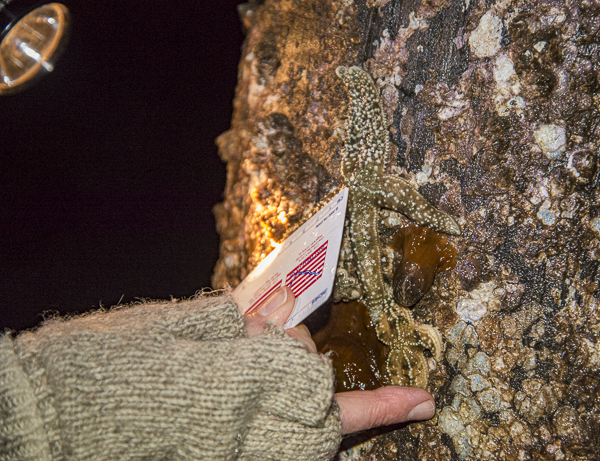
A volunteer is counting and measuring sea stars as part of a wasting disease monitoring program.
While sea urchins might delight over those observations, think of what urchins love to eat – algae, particularly bull kelp. As a result of increased numbers of urchins, some kelp forests have become kelp wildernesses. U.C. Santa Cruz and a variety of other organizations will continue to study the impact of the wasting disease on the greater ocean populations.
Until we know more, it is even more important to be increasingly mindful of the tough existence of these echinoderms. When encountering them on the shores of the Salish Sea, consider their important role in the food web and the threats to their populations and the impact of those threats. Above all, treat them with respect and hope for a brighter future for these beautiful and intriguing creatures.

Paul Pegany is a retired elementary educator who has over 30 years of experience in helping students better understand the world around them through science and literature. He splits his time between the Sonoran Desert of Arizona and the forests and seas of the Pacific Northwest. His goal is to help people of all ages better appreciate the beauty of the world, as well as understand the stewardship role that humans play as part of the greater ecosystem. Along with his wife, Sharon, he works to build his own knowledge through coursework and experiences in whichever biome he finds himself.
Table of Contents, Issue #4, Summer 2019
Windows On the Sea
by Nancy Sefton Photos & video by John F. Williams except where notedBy Nancy Sefton, Summer 2019 Photos & video by John F. Williams except where notedI am bent over double, unable to stop a steady slide down a slope of green slime, tennies soaking, shoulders...
Tide Pool Seaweed
by Sara Noland Photos & video by John F. Williams except where notedPhoto by Tom NolandIt's low tide on a lovely Pacific Northwest afternoon. The beach is an expanse of rippled mud and sand, with cobbles and scattered boulders near the water’s edge. I’ve forgotten...
Sea Cucumbers
by Paul Pegany Photos & video by John F. Williams, except where notedBy Paul Pegany, Summer 2019 Photos & video by John F. Williams except where notedSea cucumbers are elongated creatures with a mouth on one end and an anus on the other. They appear soft,...
Salish Sea Tide Pools
by Adrianne Lauman, Summer 2019 Photos & video by John F. Williams except where notedBy Adrianne Lauman, Summer 2019 Photos & video by John F. Williams except where notedA tide pool is created when a small amount of marine water is left on a shoreline or in...
Portals of Discovery
by Sharon Pegany Photos & video by John F. Williams except where notedImage courtesy of Feiro Marine Life CenterImage courtesy of Feiro Marine Life CenterBy Sharon Pegany, Summer 2019 Photos & video by John F. Williams except where notedAs spring gives way to...
Postscript 4
by John F. Williams Photos & video by John F. Williams except where notedBy John F. Williams, Summer 2019 Photos & video by John F. Williams except where notedThis issue marks a full year of publishing for Salish Magazine! I've learned a lot of lessons, and a...
FIND OUT MORE
Eisenhour, David. Eisenhour portrays and interprets organic forms, and through his artistic processes tells stories of natural history and human experience. The majority of David’s sculpture is cast in bronze and he has also worked in steel, and stainless steel.
Hackenberg, Karen. Karen is a painter, sculptor, and installation artist based in Port Townsend, WA.
Pegany, Sharon. See her Pacific Wonder Tracker blog for first-hand glimpses of our Northwest wonders.
Sea Star Wasting Syndrome, MULTI-AGENCY ROCKY INTERTIDAL NETWORK (MARINe), University of California Santa Cruz
Sound Water Stewards, Intertidal Organisms EZ-ID GUIDES has a whole section on echinoderms

